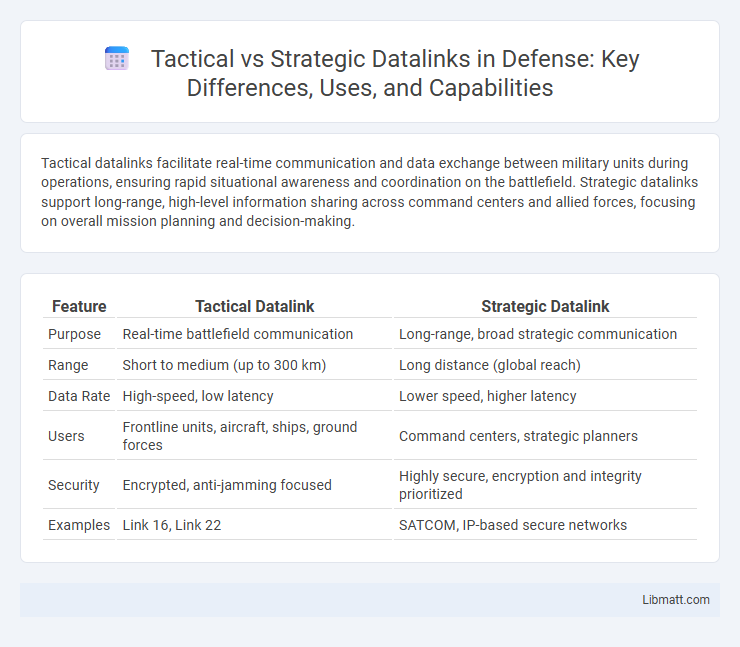Tactical datalinks facilitate real-time communication and data exchange between military units during operations, ensuring rapid situational awareness and coordination on the battlefield. Strategic datalinks support long-range, high-level information sharing across command centers and allied forces, focusing on overall mission planning and decision-making.
Table of Comparison
| Feature | Tactical Datalink | Strategic Datalink |
|---|---|---|
| Purpose | Real-time battlefield communication | Long-range, broad strategic communication |
| Range | Short to medium (up to 300 km) | Long distance (global reach) |
| Data Rate | High-speed, low latency | Lower speed, higher latency |
| Users | Frontline units, aircraft, ships, ground forces | Command centers, strategic planners |
| Security | Encrypted, anti-jamming focused | Highly secure, encryption and integrity prioritized |
| Examples | Link 16, Link 22 | SATCOM, IP-based secure networks |
Introduction to Tactical and Strategic Datalinks
Tactical datalinks enable rapid, secure communication and data exchange among military units on the battlefield, facilitating real-time situational awareness and decision-making. Strategic datalinks support long-distance, high-level communication between command centers and operational headquarters, focusing on broad mission coordination and intelligence sharing. Your choice between tactical and strategic datalinks depends on the required range, speed, and purpose of the military communication network.
Defining Tactical Datalink: Features and Capabilities
Tactical datalinks enable real-time, secure communication and data exchange between military units on the battlefield, supporting dynamic situational awareness and coordinated operations. These links prioritize low latency, high resistance to jamming, and compatibility with various platforms, including aircraft, ships, and ground forces. Key examples include Link 16 and Link 22, which provide rapid transmission of targeting data, threat information, and command instructions essential for tactical decision-making.
Understanding Strategic Datalink: Scope and Applications
Strategic datalinks enable long-range, secure communication for military and intelligence operations, connecting command centers and remote units across vast distances. Their scope includes transmitting high-level data such as operational plans, intelligence reports, and strategic commands, supporting national defense and global coordination. Your ability to leverage strategic datalinks ensures real-time situational awareness and decision-making at the highest levels of command.
Key Differences Between Tactical and Strategic Datalinks
Tactical datalinks enable real-time communication and data exchange over short to medium distances, supporting mission-critical operations such as targeting, surveillance, and command and control in dynamic combat environments. Strategic datalinks, on the other hand, facilitate long-range, high-capacity data transfer primarily between command centers and higher echelons, ensuring coordinated planning, intelligence sharing, and command directives across vast geographic areas. Your choice between tactical and strategic datalinks depends on the required range, latency, and purpose of the communication within military or defense networks.
Use Cases: Tactical Datalinks in Combat Operations
Tactical datalinks are essential for real-time battlefield communication, enabling instant data exchange between combat units, aircraft, and command centers to support coordinated maneuvers and situational awareness. These datalinks facilitate rapid target acquisition, threat identification, and dynamic mission updates in combat zones where low latency and high reliability are critical. Your forces benefit from tactical datalinks by maintaining seamless connectivity during fast-paced operations, allowing for adaptive responses to evolving combat scenarios.
Strategic Datalink Role in Command and Control
Strategic datalinks facilitate long-range, high-capacity communication essential for command and control across theater or national levels, enabling real-time data exchange between headquarters and dispersed forces. These links support integrated mission planning, intelligence sharing, and coordination of assets over vast geographic areas to enhance situational awareness and decision-making. Unlike tactical datalinks focused on immediate battlefield communication, strategic datalinks ensure continuity of operations through secure, reliable, and high-bandwidth connectivity between strategic command nodes.
Interoperability Challenges: Tactical vs Strategic Datalinks
Tactical datalinks, such as Link 16, prioritize real-time, secure communication among combat units, facing interoperability challenges due to varying protocols and encryption standards across allied forces. Strategic datalinks, like the Global Information Grid (GIG), handle long-range, high-level data exchange, encountering difficulties integrating diverse national command and control systems with differing data formats and transmission technologies. Overcoming these interoperability issues requires standardized frameworks and adaptive middleware solutions to ensure seamless data flow between tactical and strategic networks.
Security Considerations for Datalink Networks
Tactical datalink networks prioritize low-latency, encrypted communication with robust authentication protocols to maintain operational security in dynamic battlefield environments. Strategic datalink systems emphasize long-range secure transmission using layered encryption and advanced intrusion detection to protect sensitive data over extended distances. Both datalink types implement stringent access controls and continuous monitoring to mitigate cyber threats and ensure data integrity across military communication channels.
Technological Advancements in Datalink Systems
Technological advancements in tactical datalink systems emphasize real-time, secure, and high-frequency communications for battlefield awareness and rapid decision-making, leveraging improvements in encryption, latency reduction, and mesh networking. Strategic datalink systems benefit from breakthroughs in long-range satellite connectivity, bandwidth expansion, and resilient signal processing to ensure reliable command and control over vast geographic areas. Your operational efficiency depends on choosing datalink solutions optimized for either immediate tactical responsiveness or comprehensive strategic communication.
Future Trends: Integrating Tactical and Strategic Datalinks
Future trends in integrating tactical and strategic datalinks emphasize seamless interoperability, enhancing real-time data sharing across command levels to improve situational awareness and decision-making. Advanced encryption and AI-driven data processing optimize the fusion of battlefield intelligence with long-range strategic insights. Your defense systems benefit from more adaptive, resilient communication networks that bridge immediate tactical needs with overarching strategic objectives.
tactical datalink vs strategic datalink Infographic

 libmatt.com
libmatt.com